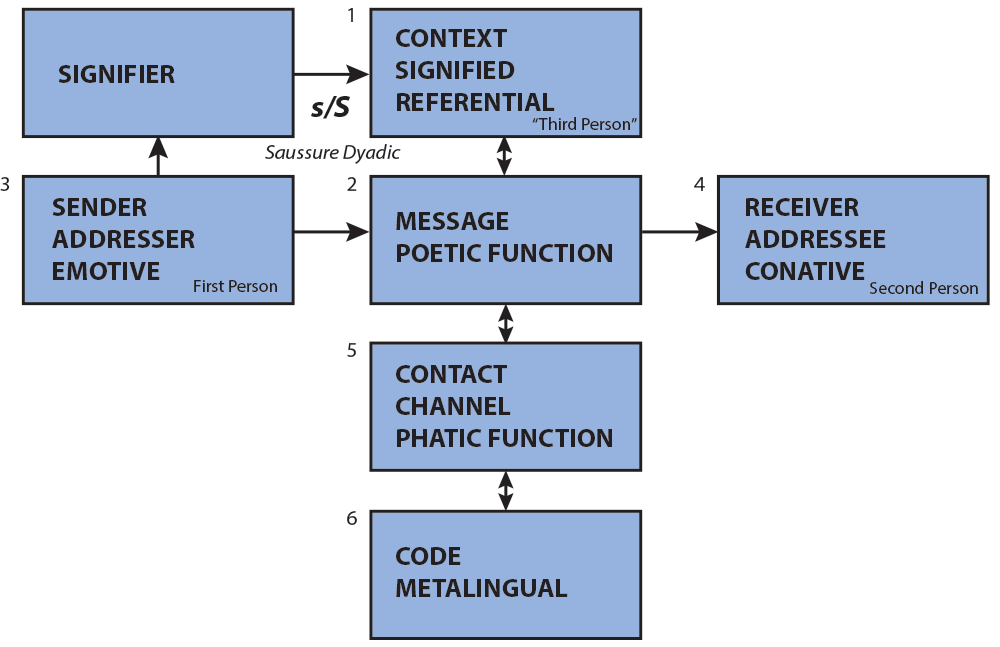Donald MacKay was a British physicist who made important contributions to cybernetics and the question of "meaning" in information theory.
MacKay contributed to the
London Symposia on Information Theory and attended the
eighth Macy Conference on Cybernetics in New York in 1951 where he met
Gregory Bateson,
Warren McCulloch,
I. A. Richards, and
Claude Shannon.
Roman Jakobson, who attended the
eighth Macy Conference, and attended some
London Symposia, encouraged MacKay to publish a collection of his several essays on Information and Meaning that had been published between 1950 and 1960.
They contain the first, and in many ways, the clearest account of how to add "meaning" to information theory, in light of Shannon's warning that his work was a theory of "communication" only, completely independent of the meaning in a message. Here is Shannon's famous sender-receiver diagram.

Jakobson added the "context" of a message to Shannon's diagram, so was in an excellent position to appreciate MacKay's work. Here is Jakobson's addition of context.

Context was perhaps Jakobson's most important addition to semiotics. Adding context gives us the difference between semantics (the standard dictionary meaning of a word according to the normal "rules" of the language) versus pragmatics, the meaning that may be intended by the sender, or should be inferred by the receiver/interpreter because of the current situation. Jakobson calls this contextual information "denotative," "cognitive," "referential," the "leading task" of a message. Context-dependence alters the "meaning" to suit the purpose of a communication.
MacKay's earliest work, at the end of World War II, behaviour of electrical pulses over extremely short intervals
of time. He wrote
Inevitably, one came up against fundamental
physical limits to the accuracy of measurement. Typically,
these limits seemed to be related in a complementary way,
so that one of them could be widened only at the expense of
a narrowing of another. An increase in time-resolving power,
for example, seemed always to be bought at the expense of
a reduction in frequency-resolving power; an improvement
in signal-to-noise ratio was often inseparable from a reduction
in time-resolving power, and so on. The art of physical
measurement seemed to be ultimately a matter of compromise,
of choosing between reciprocally related uncertainties.
I was struck by a possible analogy between this situation
and the one in atomic physics expressed by Heisenberg's
well-known 'Principle of Uncertainty'. This states that the
momentum (p) and position (q ) of a particle can never be
exactly determined at the same instant. The smaller the
imprecision (Δp) in p, the larger must be the imprecision
(Δq ) in q and vice versa. In fact, the product ΔpΔq
can never be less than Planck's Constant h, the 'quantum of
action'. Action (energy x time) is thus the fundamental
physical quantity whose 'atomicity' underlies the compromise-
relation expressed in Heisenberg's Principle.
(Information, Mechanism, and Meaning, 1969, p.1)
MacKay learned a few years later that
Dennis Gabor
derived a similar relation in 1946. He published a classic paper
entitled '
Theory of Communication', in which the Fourier transform
theory used in wave mechanics was applied to
the frequency-time (
f-t) domain of the communication
engineer, with the suggestion that a signal occupying an
elementary area of
Δf Δt = 1/2 could be regarded as a "unit
of information", which he called a "
logon".
Much earlier, in
1935, the statistician
R. A. Fisher had proposed a measure of
the "information' in a statistical sample, which in the simplest
case amounted to the reciprocal of the variance.
MacKay was not sure how Gabor's and Fisher's concepts fitted into the theory of information, but
on reflection it became
apparent that they were in fact examples of ' structural' and
' metrical' measures, respectively. Gabor's logons, each occupying
an area Δf Δt = 1/2 in the f - t plane, represented the logical
dimensions of his communication signals. They belonged to the
same family as the ' structural units' that occupy an analogous
elementary area (the Airy disc) in the focal plane of a microscope,
or of a radar aerial. It thus seemed appropriate, with
Gabor's blessing, to give the term 'logon-content' a more
general definition, as the measure of the logical dimensionality
of representations of any form, whether spatial or temporal.
Fisher's measure, which is additive for averaged samples,
invited an equally straightforward interpretation as an
index of 'weight of evidence'. If we define (arbitrarily but
reasonably) a unit or quantum of metrical information
(termed a 'metron') as the weight of evidence that gives a
probability of \ to the corresponding proposition, Fisher's
'amount of information' becomes simply proportional to
the number of such units supplied by the evidence in question
(Information, Mechanism, and Meaning, 1969, p.4)